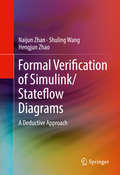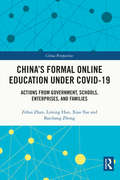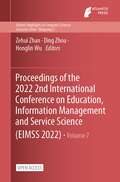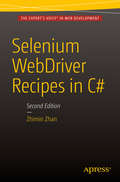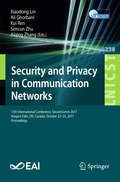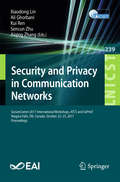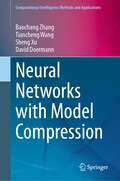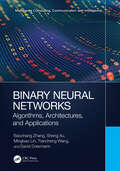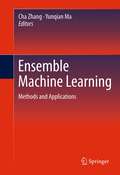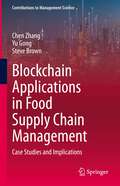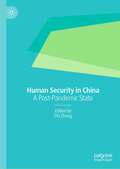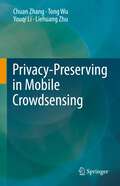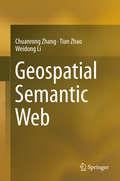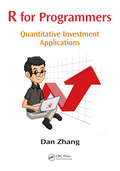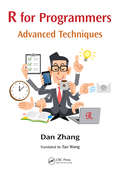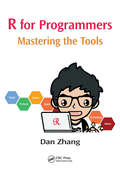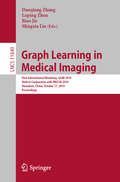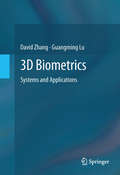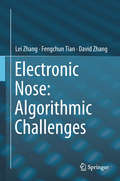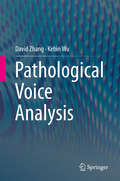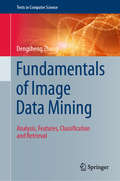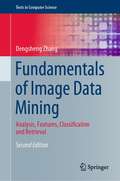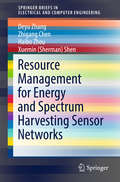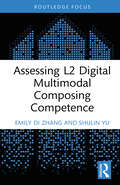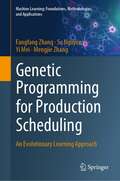- Table View
- List View
Formal Verification of Simulink/Stateflow Diagrams
by Naijun Zhan Shuling Wang Hengjun ZhaoThis book presents a state-of-the-art technique for formal verification of continuous-time Simulink/Stateflow diagrams, featuring an expressive hybrid system modelling language, a powerful specification logic and deduction-based verification approach, and some impressive, realistic case studies. Readers will learn the HCSP/HHL-based deductive method and the use of corresponding tools for formal verification of Simulink/Stateflow diagrams. They will also gain some basic ideas about fundamental elements of formal methods such as formal syntax and semantics, and especially the common techniques applied in formal modelling and verification of hybrid systems. By investigating the successful case studies, readers will realize how to apply the pure theory and techniques to real applications, and hopefully will be inspired to start to use the proposed approach, or even develop their own formal methods in their future work.
China's Formal Online Education under COVID-19: Actions from Government, Schools, Enterprises, and Families (China Perspectives)
by Zehui Zhan Liming Huo Xiao Yao Baichang ZhongThis book investigates how schools, enterprises and families in China have coped with the formal online education in the light of government policy throughout the COVID-19 epidemic outbreak, with special focus on the problems they have encountered and possible solutions. Using grounded theory, over 1000 posts retrieved from public online forums were analyzed under a 4*4 framework, referring to four special time nodes (proposal period, exploratory period, full deployed period, exiting period) and four major subjects (government, schools, enterprises, families). The book identifies four main issues faced by massive online education during the epidemic: platform selection in proposal period, teacher training in exploratory period, resource integration in full deployed period, and flexibility of returning to schools in exiting period. These findings enlighten us with a deeper understanding of the process of online learning in an educational emergency, helping to develop best countermeasures in similar situations, as well as to provide paths to follow for other countries. The book will appeal to teachers, researchers and school administrators of the online education and education emergency management, as well as those who are interested in Chinese education during the COVID-19 outbreak in general.
Proceedings of the 2022 2nd International Conference on Education, Information Management and Service Science (Atlantis Highlights in Computer Sciences #7)
by Zehui Zhan Ding Zhou Honglin WuThis is an open access book. 2022 2nd International Conference on Education, Information Management and Service Science (EIMSS 2022)was held on July 22–24, 2022 in Changsha, China. EIMSS 2022 is to bring together innovative academics and industrial experts in the field of Education, Information Management and Service Science to a common forum. The primary goal of the conference is to promote research and developmental activities in Education, Information Management and Service Science and another goal is to promote scientific information interchange between researchers, developers, engineers, students, and practitioners working all around the world. The conference will be held every year to make it an ideal platform for people to share views and experiences in Education, Information Management and Service Science and related areas.
Selenium WebDriver Recipes in C#
by Zhimin ZhanSolve your Selenium WebDriver problems with this quick guide to automated testing of web applications with Selenium WebDriver in C#. Selenium WebDriver Recipes in C#, Second Edition contains hundreds of solutions to real-world problems, with clear explanations and ready-to-run Selenium test scripts that you can use in your own projects. What you'll learn How to locate web elements and test functions for hyperlinks, buttons, TextFields and TextAreas, radio buttons, CheckBoxes, and more How to use Selenium WebDriver for select lists, navigation, assertions, frames, file upload and pop-up dialogs How to debug test scripts and test data How to manage and deal with browser profiles and capabilities How to manage tests for advanced user interactions and experiences (UX) How to work with and manage tests and testing using Selenium Remote Control and Selenium Server Who this book is for This book is for experienced Windows application developers working with . NET and especially C#. Table of Contents 1. Introduction 2. Locating Web Elements 3. Hyperlink 4. Button 5. TestField and TextArea 6. Radio Button 7. CheckBox 8. Select List 9. Navigation and Browser 10. Assertion 11. Frames 12. Testing Ajax 13. File Upload and Pop-up Dialogs 14. Debugging Test Scripts 15. Test Data 16. Browser Profile and Capabilities 17. Advanced User Interactions 18. HTML5 and Dynamic Web Sites 19. WYSIWYG HTML Editors 20. Advanced Topics 21. Selenium Remote Control Server 22. Afterword A. Resources
Security and Privacy in Communication Networks: 12th International Conference, Securecomm 2016, Guangzhou, China, October 10-12, 2016, Proceedings (Lecture Notes of the Institute for Computer Sciences, Social Informatics and Telecommunications Engineering #198)
by Aiqing Zhang Sencun Zhu Kui Ren Ali Ghorbani Xiaodong LinThis book constitutes the thoroughly refereed roceedings of the 13th International Conference on Security and Privacy in Communications Networks, SecureComm 2017, held in Niagara Falls, ON, Canada, in October 2017.The 31 revised regular papers and 15 short papers were carefully reviewed and selected from 105 submissions. The topics range from security and privacy in machine learning to differential privacy, which are currently hot research topics in cyber security research.
Security and Privacy in Communication Networks: 12th International Conference, Securecomm 2016, Guangzhou, China, October 10-12, 2016, Proceedings (Lecture Notes of the Institute for Computer Sciences, Social Informatics and Telecommunications Engineering #198)
by Aiqing Zhang Sencun Zhu Kui Ren Ali Ghorbani Xiaodong LinThis book constitutes the refereed proceedings of two workshops held at the 13th International Conference on Security and Privacy in Communications Networks, SecureComm 2017, held in Niagara Falls, ON, Canada, in October 2017: the 5th International Workshop on Applications and Techniques in Cyber Security, ATCS 2017, and the First Workshop on Security and Privacy in the Internet Of Things, SePrIoT 2017.The 22 revised regular papers were carefully reviewed and selected from 105 submissions. The topics range from access control; language-based security; malicious software; network security; cloud security; software security; operating system security; privacy protection, database security, security models; and many more.The SePrIoT workshop targets to address novel approaches in security and privacy. The papers focuse, amongst others, on novel models, techniques, protocols, algorithms, or architectures.
Neural Networks with Model Compression (Computational Intelligence Methods and Applications)
by Baochang Zhang Tiancheng Wang Sheng Xu David DoermannDeep learning has achieved impressive results in image classification, computer vision and natural language processing. To achieve better performance, deeper and wider networks have been designed, which increase the demand for computational resources. The number of floating-point operations (FLOPs) has increased dramatically with larger networks, and this has become an obstacle for convolutional neural networks (CNNs) being developed for mobile and embedded devices. In this context, our book will focus on CNN compression and acceleration, which are important for the research community. We will describe numerous methods, including parameter quantization, network pruning, low-rank decomposition and knowledge distillation. More recently, to reduce the burden of handcrafted architecture design, neural architecture search (NAS) has been used to automatically build neural networks by searching over a vast architecture space. Our book will also introduce NAS due to its superiority and state-of-the-art performance in various applications, such as image classification and object detection. We also describe extensive applications of compressed deep models on image classification, speech recognition, object detection and tracking. These topics can help researchers better understand the usefulness and the potential of network compression on practical applications. Moreover, interested readers should have basic knowledge about machine learning and deep learning to better understand the methods described in this book.
Binary Neural Networks: Algorithms, Architectures, and Applications (Multimedia Computing, Communication and Intelligence)
by Baochang Zhang Sheng Xu Mingbao Lin Tiancheng Wang David DoermannDeep learning has achieved impressive results in image classification, computer vision, and natural language processing. To achieve better performance, deeper and wider networks have been designed, which increase the demand for computational resources. The number of floatingpoint operations (FLOPs) has increased dramatically with larger networks, and this has become an obstacle for convolutional neural networks (CNNs) being developed for mobile and embedded devices. In this context, Binary Neural Networks: Algorithms, Architectures, and Applications will focus on CNN compression and acceleration, which are important for the research community. We will describe numerous methods, including parameter quantization, network pruning, low-rank decomposition, and knowledge distillation. More recently, to reduce the burden of handcrafted architecture design, neural architecture search (NAS) has been used to automatically build neural networks by searching over a vast architecture space. Our book will also introduce NAS and binary NAS and its superiority and state-of-the-art performance in various applications, such as image classification and object detection. We also describe extensive applications of compressed deep models on image classification, speech recognition, object detection, and tracking. These topics can help researchers better understand the usefulness and the potential of network compression on practical applications. Moreover, interested readers should have basic knowledge of machine learning and deep learning to better understand the methods described in this book. Key Features • Reviews recent advances in CNN compression and acceleration • Elaborates recent advances on binary neural network (BNN) technologies • Introduces applications of BNN in image classification, speech recognition, object detection, and more Baochang Zhang is a full professor with the Institute of Artificial Intelligence, Beihang University, Beijing, China. He was selected by the Program for New Century Excellent Talents in the University of Ministry of Education of China, chosen as the Academic Advisor of the Deep Learning Lab of Baidu Inc., and was honored as a Distinguished Researcher of Beihang Hangzhou Institute in Zhejiang Province. His research interests include explainable deep learning, computer vision, and pattern recognition. His HGPP and LDP methods were state-of-the-art feature descriptors, with 1234 and 768 Google Scholar citations, respectively, and both “Test-of-Time” works. His team’s 1-bit methods achieved the best performance on ImageNet. His group also won the ECCV 2020 Tiny Object Detection, COCO Object Detection, and ICPR 2020 Pollen recognition challenges. Sheng Xu received a BE in automotive engineering from Beihang University, Beijing, China. He has a PhD and is currently at the School of Automation Science and Electrical Engineering, Beihang University, specializing in computer vision, model quantization, and compression. He has made significant contributions to the field and has published about a dozen papers as the first author in top-tier conferences and journals such as CVPR, ECCV, NeurIPS, AAAI, BMVC, IJCV, and ACM TOMM. Notably, he has 4 papers selected as oral or highlighted presentations by these prestigious conferences. Furthermore, Dr. Xu actively participates in the academic community as a reviewer for various international journals and conferences, including CVPR, ICCV, ECCV, NeurIPS, ICML, and IEEE TCSVT. His expertise has also led to his group’s victory in the ECCV 2020 Tiny Object Detection Challenge. Mingbao Lin finished his MS-PhD study and obtained a PhD in intelligence science and technology from Xiamen University, Xiamen, China in 2022. In 2016, he received a BS from Fuzhou University, Fuzhou, China. He is currently a senior researcher with the Tencent Youtu Lab, Shanghai, China. His publications on top-tier conferences/journals include: IEEE TP
Ensemble Machine Learning: Methods and Applications
by Cha Zhang Yunqian MaIt is common wisdom that gathering a variety of views and inputs improves the process of decision making, and, indeed, underpins a democratic society. Dubbed "ensemble learning" by researchers in computational intelligence and machine learning, it is known to improve a decision system's robustness and accuracy. Now, fresh developments are allowing researchers to unleash the power of ensemble learning in an increasing range of real-world applications. Ensemble learning algorithms such as "boosting" and "random forest" facilitate solutions to key computational issues such as face recognition and are now being applied in areas as diverse as object tracking and bioinformatics. Responding to a shortage of literature dedicated to the topic, this volume offers comprehensive coverage of state-of-the-art ensemble learning techniques, including the random forest skeleton tracking algorithm in the Xbox Kinect sensor, which bypasses the need for game controllers. At once a solid theoretical study and a practical guide, the volume is a windfall for researchers and practitioners alike.
Blockchain Applications in Food Supply Chain Management: Case Studies and Implications (Contributions to Management Science)
by Chen Zhang Yu Gong Steve BrownThis book contributes to blockchain applications in food supply chain management from both theoretical and practical perspectives. By using the case study research method, it empirically investigates why and how food companies implement blockchain technology. Moreover, it proposes a conceptual framework based on the case findings and extant literature. The book provides empirical evidence to verify academic findings such as critical success factors and barriers. Furthermore, it identifies the implementation process to answer the ‘how’ question. Uniquely, it applies the innovation process model and the practice-based view (PBV) to studies on food supply chains and blockchain. Thus, building on the original model and theory, it enriches the theory on blockchain implementation, making it a valuable asset for all researchers and practitioners interested in blockchain adoption and food supply chain management.
Human Security in China: A Post-Pandemic State
by Chi ZhangThis book explores the emergent concept of 'human security' within the political context of COVID-19 Chinese politics. For decades, Western nations have used 'human rights' as a rubric with which to scold Chinese leaders, betraying a fundamental unwillingness to accept diversity of governance systems. As COVID-19 has demonstrated, different governance systems yield different outcomes—the freedom of circulation, speech and movement in Western democracies yielding one, and use of surveillance, lockdowns, and private–public collaboration in China and Asian societies such as Korea and Singapore yielding another. Chinese political scientists have become fixated on the notion of 'human security,' a utilitarian concept which insists on the importance of protecting and extending human life via health care, technology, and a wide range of other systems—sometimes, in ways which contradict Western notions of human rights, even as they demonstrably achieve superior outcomes for the humans involved. Being the first English language book to explore these issues, this book aims to generate a sustained theoretical relevance in the aftermath of the crisis which is likely to have lasting effects on how people live and will be of note for political scientists, China scholars, and economists.
Privacy-Preserving in Mobile Crowdsensing
by Chuan Zhang Tong Wu Youqi Li Liehuang ZhuMobile crowdsensing is a new sensing paradigm that utilizes the intelligence of a crowd of individuals to collect data for mobile purposes by using their portable devices, such as smartphones and wearable devices. Commonly, individuals are incentivized to collect data to fulfill a crowdsensing task released by a data requester. This “sensing as a service” elaborates our knowledge of the physical world by opening up a new door of data collection and analysis. However, with the expansion of mobile crowdsensing, privacy issues urgently need to be solved. In this book, we discuss the research background and current research process of privacy protection in mobile crowdsensing. In the first chapter, the background, system model, and threat model of mobile crowdsensing are introduced. The second chapter discusses the current techniques to protect user privacy in mobile crowdsensing. Chapter three introduces the privacy-preserving content-based task allocation scheme. Chapter four further introduces the privacy-preserving location-based task scheme. Chapter five presents the scheme of privacy-preserving truth discovery with truth transparency. Chapter six proposes the scheme of privacy-preserving truth discovery with truth hiding. Chapter seven summarizes this monograph and proposes future research directions. In summary, this book introduces the following techniques in mobile crowdsensing: 1) describe a randomizable matrix-based task-matching method to protect task privacy and enable secure content-based task allocation; 2) describe a multi-clouds randomizable matrix-based task-matching method to protect location privacy and enable secure arbitrary range queries; and 3) describe privacy-preserving truth discovery methods to support efficient and secure truth discovery. These techniques are vital to the rapid development of privacy-preserving in mobile crowdsensing.
Geospatial Semantic Web
by Chuanrong Zhang Tian Zhao Weidong LiThis book covers key issues related to Geospatial Semantic Web, including geospatial web services for spatial data interoperability; geospatial ontology for semantic interoperability; ontology creation, sharing, and integration; querying knowledge and information from heterogeneous data source; interfaces for Geospatial Semantic Web, VGI (Volunteered Geographic Information) and Geospatial Semantic Web; challenges of Geospatial Semantic Web; and development of Geospatial Semantic Web applications. This book also describes state-of-the-art technologies that attempt to solve these problems such as WFS, WMS, RDF, OWL and GeoSPARQL and demonstrates how to use the Geospatial Semantic Web technologies to solve practical real-world problems such as spatial data interoperability.
R for Programmers: Quantitative Investment Applications
by Dan ZhangAfter the fundamental volume and the advanced technique volume, this volume focuses on R applications in the quantitative investment area. Quantitative investment has been hot for some years, and there are more and more startups working on it, combined with many other internet communities and business models. R is widely used in this area, and can be a very powerful tool. The author introduces R applications with cases from his own startup, covering topics like portfolio optimization and risk management.
R for Programmers: Advanced Techniques
by Dan ZhangThis book discusses advanced topics such as R core programing, object oriented R programing, parallel computing with R, and spatial data types. The author leads readers to merge mature and effective methdologies in traditional programing to R programing. It shows how to interface R with C, Java, and other popular programing laguages and platforms.
R for Programmers: Mastering the Tools
by Dan ZhangUnlike other books about R, written from the perspective of statistics, this book is written from the perspective of programmers, providing a channel for programmers with expertise in other programming languages to quickly understand R. The contents are divided into four parts: the basics of R, the server of R, databases and big data, and the appendices, which introduce the installation of Java, various databases, and Hadoop. Because this is a reference book, there is no special sequence for reading all the chapters. Anyone new to the subject who wishes to master R comprehensively can simply follow the chapters in sequence.
Graph Learning in Medical Imaging: First International Workshop, GLMI 2019, Held in Conjunction with MICCAI 2019, Shenzhen, China, October 17, 2019, Proceedings (Lecture Notes in Computer Science #11849)
by Daoqiang Zhang Luping Zhou Biao Jie Mingxia LiuThis book constitutes the refereed proceedings of the First International Workshop on Graph Learning in Medical Imaging, GLMI 2019, held in conjunction with MICCAI 2019 in Shenzhen, China, in October 2019. The 21 full papers presented were carefully reviewed and selected from 42 submissions. The papers focus on major trends and challenges of graph learning in medical imaging and present original work aimed to identify new cutting-edge techniques and their applications in medical imaging.
3D Biometrics: Systems and Applications
by David Zhang Guangming LuAutomatic personal authentication using biometric information is becoming more essential in applications of public security, access control, forensics, banking, etc. Many kinds of biometric authentication techniques have been developed based on different biometric characteristics. However, most of the physical biometric recognition techniques are based on two dimensional (2D) images, despite the fact that human characteristics are three dimensional (3D) surfaces. Recently, 3D techniques have been applied to biometric applications such as 3D face, 3D palmprint, 3D fingerprint, and 3D ear recognition. This book introduces four typical 3D imaging methods, and presents some case studies in the field of 3D biometrics. This book also includes many efficient 3D feature extraction, matching, and fusion algorithms. These 3D imaging methods and their applications are given as follows: - Single view imaging with line structured-light: 3D ear identification - Single view imaging with multi-line structured-light: 3D palmprint authentication - Single view imaging using only 3D camera: 3D hand verification - Multi-view imaging: 3D fingerprint recognition 3D Biometrics: Systems and Applications is a comprehensive introduction to both theoretical issues and practical implementation in 3D biometric authentication. It will serve as a textbook or as a useful reference for graduate students and researchers in the fields of computer science, electrical engineering, systems science, and information technology. Researchers and practitioners in industry and R&D laboratories working on security system design, biometrics, immigration, law enforcement, control, and pattern recognition will also find much of interest in this book.
Electronic Nose: Algorithmic Challenges
by David Zhang Fengchun Tian Lei ZhangThis book presents the key technology of electronic noses, and systematically describes how e-noses can be used to automatically analyse odours. Appealing to readers from the fields of artificial intelligence, computer science, electrical engineering, electronics, and instrumentation science, it addresses three main areas: First, readers will learn how to apply machine learning, pattern recognition and signal processing algorithms to real perception tasks. Second, they will be shown how to make their algorithms match their systems once the algorithms don’t work because of the limitation of hardware resources. Third, readers will learn how to make schemes and solutions when the acquired data from their systems is not stable due to the fundamental issues affecting perceptron devices (e.g. sensors). In brief, the book presents and discusses the key technologies and new algorithmic challenges in electronic noses and artificial olfaction. The goal is to promote the industrial application of electronic nose technology in environmental detection, medical diagnosis, food quality control, explosive detection, etc. and to highlight the scientific advances in artificial olfaction and artificial intelligence. The book offers a good reference guide for newcomers to the topic of electronic noses, because it refers to the basic principles and algorithms. At the same time, it clearly presents the key challenges – such as long-term drift, signal uniqueness, and disturbance – and effective and efficient solutions, making it equally valuable for researchers engaged in the science and engineering of sensors, instruments, chemometrics, etc.
Pathological Voice Analysis
by David Zhang Kebin WuWhile voice is widely used in speech recognition and speaker identification, its application in biomedical fields is much less common. This book systematically introduces the authors’ research on voice analysis for biomedical applications, particularly pathological voice analysis. Firstly, it reviews the field to highlight the biomedical value of voice. It then offers a comprehensive overview of the workflow and aspects of pathological voice analysis, including voice acquisition systems, voice pitch estimation methods, glottal closure instant detection, feature extraction and learning, and the multi-audio fusion approaches. Lastly, it discusses the experimental results that have shown the superiority of these techniques. This book is useful to researchers, professionals and postgraduate students working in fields such as speech signal processing, pattern recognition, and biomedical engineering. It is also a valuable resource for those involved in interdisciplinary research.
Fundamentals of Image Data Mining: Analysis, Features, Classification and Retrieval (Texts in Computer Science)
by Dengsheng ZhangThis reader-friendly textbook presents a comprehensive review of the essentials of image data mining, and the latest cutting-edge techniques used in the field. The coverage spans all aspects of image analysis and understanding, offering deep insights into areas of feature extraction, machine learning, and image retrieval. The theoretical coverage is supported by practical mathematical models and algorithms, utilizing data from real-world examples and experiments.Topics and features: describes the essential tools for image mining, covering Fourier transforms, Gabor filters, and contemporary wavelet transforms; reviews a varied range of state-of-the-art models, algorithms, and procedures for image mining; emphasizes how to deal with real image data for practical image mining; highlights how such features as color, texture, and shape can be mined or extracted from images for image representation; presents four powerful approaches for classifying image data, namely, Bayesian classification, Support Vector Machines, Neural Networks, and Decision Trees; discusses techniques for indexing, image ranking, and image presentation, along with image database visualization methods; provides self-test exercises with instructions or Matlab code, as well as review summaries at the end of each chapter.This easy-to-follow work illuminates how concepts from fundamental and advanced mathematics can be applied to solve a broad range of image data mining problems encountered by students and researchers of computer science. Students of mathematics and other scientific disciplines will also benefit from the applications and solutions described in the text, together with the hands-on exercises that enable the reader to gain first-hand experience of computing.
Fundamentals of Image Data Mining: Analysis, Features, Classification and Retrieval (Texts in Computer Science)
by Dengsheng ZhangThis unique and useful textbook presents a comprehensive review of the essentials of image data mining, and the latest cutting-edge techniques used in the field. The coverage spans all aspects of image analysis and understanding, offering deep insights into areas of feature extraction, machine learning, and image retrieval. The theoretical coverage is supported by practical mathematical models and algorithms, utilizing data from real-world examples and experiments. Topics and features: Describes essential tools for image mining, covering Fourier transforms, Gabor filters, and contemporary wavelet transformsDevelops many new exercises (most with MATLAB code and instructions)Includes review summaries at the end of each chapterAnalyses state-of-the-art models, algorithms, and procedures for image miningIntegrates new sections on pre-processing, discrete cosine transform, and statistical inference and testingDemonstrates how features like color, texture, and shape can be mined or extracted for image representationApplies powerful classification approaches: Bayesian classification, support vector machines, neural networks, and decision treesImplements imaging techniques for indexing, ranking, and presentation, as well as database visualization This easy-to-follow, award-winning book illuminates how concepts from fundamental and advanced mathematics can be applied to solve a broad range of image data mining problems encountered by students and researchers of computer science. Students of mathematics and other scientific disciplines will also benefit from the applications and solutions described in the text, together with the hands-on exercises that enable the reader to gain first-hand experience of computing.
Resource Management for Energy and Spectrum Harvesting Sensor Networks
by Deyu Zhang Zhigang Chen Haibo Zhou Xuemin Sherman ShenThis SpringerBrief offers a comprehensive review and in-depth discussion of the current research on resource management. The authors explain how to best utilize harvested energy and temporally available licensed spectrum. Throughout the brief, the primary focus is energy and spectrum harvesting sensor networks (ESHNs) including energy harvesting (EH)-powered spectrum sensing and dynamic spectrum access. To efficiently collect data through the available licensed spectrum, this brief examines the joint management of energy and spectrum. An EH-powered spectrum sensing and management scheme for Heterogeneous Spectrum Harvesting Sensor Networks (HSHSNs) is presented in this brief. The scheme dynamically schedules the data sensing and spectrum access of sensors in ESHSNs to optimize the network utility, while considering the stochastic nature of EH process, PU activities and channel conditions. This brief also provides useful insights for the practical resource management scheme design for ESHSNs and motivates a new line of thinking for future sensor networking. Professionals, researchers, and advanced-level students in electrical or computer engineering will find the content valuable.
Assessing L2 Digital Multimodal Composing Competence (Routledge Focus on Applied Linguistics)
by Emily Di Zhang Shulin YuThis book focuses on assessing L2 student digital multimodal composing (DMC) competence. It explores key themes, including the conceptualization of L2 student DMC competence, and the development, validation, and utilization of L2 student DMC competence in the tertiary context.Through a thorough review of the DMC literature, the book furnishes readers with a theoretical framework to comprehensively grasp the underlying constructs of L2 student DMC competence. It also provides a delineation of the process of scale development, i.e., defining constructs, constructing items, and analyzing items, scale validation, i.e., the structural, external, and consequential construct validity of the scale, and scale utilization in students’ DMC self- and peer-assessment practices.This practical guidance equips educators and practitioners with the necessary tools and strategies to effectively assess and enhance L2 students’ DMC competence. Scholars and professionals in the fields of L2 writing, language assessment, digital literacy, and technology-enhanced language learning will gain valuable insights from the content.
Genetic Programming for Production Scheduling: An Evolutionary Learning Approach (Machine Learning: Foundations, Methodologies, and Applications)
by Fangfang Zhang Su Nguyen Yi Mei Mengjie ZhangThis book introduces readers to an evolutionary learning approach, specifically genetic programming (GP), for production scheduling. The book is divided into six parts. In Part I, it provides an introduction to production scheduling, existing solution methods, and the GP approach to production scheduling. Characteristics of production environments, problem formulations, an abstract GP framework for production scheduling, and evaluation criteria are also presented. Part II shows various ways that GP can be employed to solve static production scheduling problems and their connections with conventional operation research methods. In turn, Part III shows how to design GP algorithms for dynamic production scheduling problems and describes advanced techniques for enhancing GP’s performance, including feature selection, surrogate modeling, and specialized genetic operators. In Part IV, the book addresses how to use heuristics to deal with multiple, potentially conflicting objectives in production scheduling problems, and presents an advanced multi-objective approach with cooperative coevolution techniques or multi-tree representations. Part V demonstrates how to use multitask learning techniques in the hyper-heuristics space for production scheduling. It also shows how surrogate techniques and assisted task selection strategies can benefit multitask learning with GP for learning heuristics in the context of production scheduling. Part VI rounds out the text with an outlook on the future.Given its scope, the book benefits scientists, engineers, researchers, practitioners, postgraduates, and undergraduates in the areas of machine learning, artificial intelligence, evolutionary computation, operations research, and industrial engineering.
